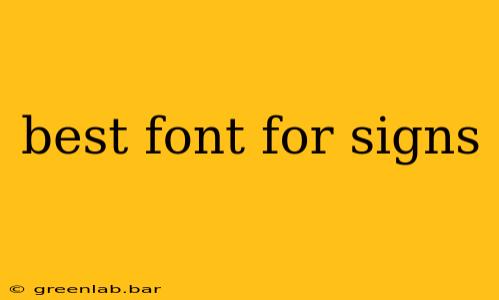Choosing the right font for your sign is crucial. It directly impacts how easily your message is understood, and ultimately, the success of your signage. A poorly chosen font can lead to confusion, missed opportunities, and even safety hazards. This guide delves into the key factors to consider when selecting the best font for your signs, covering everything from readability at a distance to the overall aesthetic impact.
Key Factors to Consider When Choosing a Sign Font
Several critical elements influence font selection for signage. Let's explore them in detail:
1. Readability from a Distance: Legibility is Paramount
This is arguably the most important factor. No matter how aesthetically pleasing your font is, if it's unreadable from a distance, it's a failure. Consider these points:
- Simplicity: Simple, sans-serif fonts like Arial, Helvetica, or Verdana are generally best for readability from afar. Their clean lines and lack of decorative elements make them easy to decipher quickly.
- Stroke Weight: A bold or heavy font weight is crucial for visibility, especially in larger signs or those viewed from a distance. Thin fonts can become illegible quickly.
- Letter Spacing (Kerning): Proper kerning is essential for ensuring letters don't appear crowded together, improving overall readability.
- Font Size: Obviously, the larger the font size, the more readable it will be. Always ensure sufficient size for the viewing distance.
2. The Context of Your Sign: Where and Why?
The location and purpose of your sign significantly influence font choice.
- Outdoor Signs: Weather resistance and high visibility are paramount. Simple, bold sans-serif fonts are ideal. Consider the background and potential glare; a contrasting color scheme is essential.
- Indoor Signs: You have more flexibility here, potentially using more decorative fonts, but readability remains critical.
- Directional Signs: Clarity is key. Use simple, easily recognizable fonts to avoid confusion.
- Informational Signs: Readability should be prioritized. Clear, concise fonts in a legible size are necessary.
3. Aesthetic Considerations: Brand and Style
While readability takes precedence, the overall aesthetic of your sign matters. Your font choice should align with your brand identity and the overall message you're trying to convey.
- Brand Consistency: Maintain consistency with your existing branding guidelines. If you have a specific brand font, use it.
- Style and Tone: Consider the overall tone you want to project. A playful script font might be suitable for a children's store, but inappropriate for a law firm.
4. Accessibility: Inclusive Font Choices
Inclusive design considers the needs of everyone, including those with visual impairments.
- Font Size and Contrast: Ensure sufficient size and contrast between the text and background for optimal readability for individuals with low vision.
- Font Choice: Some fonts are inherently easier to read for people with dyslexia or other visual processing challenges.
Best Fonts for Signs: Examples and Recommendations
While the "best" font depends heavily on context, here are some strong contenders often recommended for various signage applications:
- Arial: A classic, versatile sans-serif font, highly readable and widely available. Excellent for most signage applications.
- Helvetica: Similar to Arial, known for its clean, modern appearance and excellent readability.
- Verdana: Designed for on-screen readability, Verdana also performs well in print signage, particularly at smaller sizes.
- Open Sans: An open-source font, highly legible and suitable for digital and print applications.
Fonts to Avoid (Generally):
Avoid highly decorative or script fonts, which are often difficult to read, especially from a distance. Extremely thin or excessively stylized fonts should also be avoided.
Conclusion: Choose Wisely for Maximum Impact
Selecting the right font for your signs is a crucial design decision. By prioritizing readability, considering the context, and aligning your font choice with your brand and accessibility requirements, you can create signage that effectively communicates your message and leaves a lasting impression. Remember to always test your chosen font in its intended environment before finalizing your design.

